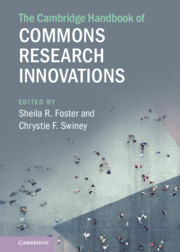Book contents
- The Cambridge Handbook of Commons Research Innovations
- The Cambridge Handbook of Commons Research Innovations
- Copyright page
- Contents
- Figures
- Tables
- Contributors
- Introduction
- Part I Revisiting the Origins and Evolution of Commons Thought
- Part II Averting New Tragedies
- Part III New Forms of Contested Commons
- Part IV Urban Landscape and Infrastructure as a Commons
- Part V Reassessing Old and New Institutions for Collective Action
- Part VI Managing and Restoring the Commons
- 17 Management of Facilitated Common Pool Resources in India
- 18 Social Environmental Dilemmas and Governing the Commons
- 19 Social Trust, Informal Institutions and Community-Based Wildlife Management in Namibia and Tanzania
- 20 Restoring the Commons
- Part VII Law, Legal Theory, and the Commons
- Part VIII Technology, the Internet, and the Future of Commons Governance
- Index
20 - Restoring the Commons
from Part VI - Managing and Restoring the Commons
Published online by Cambridge University Press: 29 October 2021
- The Cambridge Handbook of Commons Research Innovations
- The Cambridge Handbook of Commons Research Innovations
- Copyright page
- Contents
- Figures
- Tables
- Contributors
- Introduction
- Part I Revisiting the Origins and Evolution of Commons Thought
- Part II Averting New Tragedies
- Part III New Forms of Contested Commons
- Part IV Urban Landscape and Infrastructure as a Commons
- Part V Reassessing Old and New Institutions for Collective Action
- Part VI Managing and Restoring the Commons
- 17 Management of Facilitated Common Pool Resources in India
- 18 Social Environmental Dilemmas and Governing the Commons
- 19 Social Trust, Informal Institutions and Community-Based Wildlife Management in Namibia and Tanzania
- 20 Restoring the Commons
- Part VII Law, Legal Theory, and the Commons
- Part VIII Technology, the Internet, and the Future of Commons Governance
- Index
Summary
Modern development with its construction of every square inch of possible space, destroys open spaces, and commons.This building is generally haphazard, occurring in cities, suburbs and exurbs. It obliterates ecosystems and habitats.The results of this development and the effects of climate change, is exemplified in the United States by the repeated flooding of cities like Ellicott, MD; Houston, TX; Miami, FL; and Wilmington, NC;and the wildfires in the West.These areas bear the brunt of the abandonment of entire towns and their economic losses.But a reverse trend is also occurring: the construction of new commons, including artificial wetlands, and urban parks, that decrease impervious land, and aid in annulling the impacts of climate change.Two examples of this phenomenon are presented.First, on the outskirts of Tel Aviv, Israel, is a reclamation of a dry riverbed, previously employed to convey raw sewage from the Palestinian territories, via Israel into the Mediterranean Sea. The second, is the construction of an artificial wetland used to treat sewage in Orlando, FL.It has become a home for numerous species and is also used for hiking trails.These reclaimed areas are then assessed utilizing Elinor Ostrom’s common-pool resources (CPR).
- Type
- Chapter
- Information
- The Cambridge Handbook of Commons Research Innovations , pp. 242 - 252Publisher: Cambridge University PressPrint publication year: 2021



